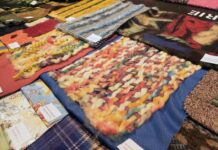Featured on Knitting Industry Creative earlier this year during New Designers 2019, London based knitwear designer Olivia J Holland aims to push consumer preconceptions of knitwear, presenting exquisitely crafted silk scarves and accessories. Combining luxurious yarns with hand crafted stitches, her bespoke collections radiate saturated, vibrant colours and offer garments to be treasured and enjoyed. With the endorsement of Cockpit Arts, Olivia is building her brand as both designer and maker.

During London Design Festival, Olivia presented her work within the painted hall at The Old Royal Naval College, Greenwich. The chance to show her work in such historical, breathtaking surroundings was an early career highlight. The colours of the decorative walls provided the perfect backdrop for Olivia’s multi-coloured knits. Considering how best to present her work within such a grand setting was a challenge for Olivia, as well as working out how to communicate her brand identity to the general public throughout LDF. The frame on which she draped her accessories was a clever, eye-catching solution.
Growing up in South London, self-confessed ‘home bird’ Olivia studied BA Textile Design at Chelsea College of Art and Design, where she specialised in Knitwear. Initially finding knitting to be frustrating, it was after mastering the craft that Olivia began to appreciate the joy held in the complexities of the knitted stitch. Understanding the nuances of the machinery and appreciating the level of understanding needed to be a successful knitwear designer, she embraced the intricacies of her new-found specialism.
Olivia values longevity, individuality and quality in her designs. She aims to reduce the amount of waste in the textiles industry from fast fashion, and inherently aligns herself with the mantras of slow fashion.
The handmade nature of her work reflects her ideals of individuality and uniqueness, with no two pieces ever being the same. Speaking about her ambitions, Olivia explained,
“If I can make a piece which someone loves and treasures forever- perhaps passes it down in their family- I believe I will have done my job as a designer. For me the piece needs to last emotionally as well as physically, which is why quality in design and material choice is important.”

Olivia’s most recent project The Berlin Collection reflects her inspiration taken from architecture and her surroundings. Finding as much inspiration in a dilapidated estate as she does in more conventionally attractive scenes, she finds beauty in unexpected places. From her own photography she gathers colour, yarn and silhouette inspiration. Her vast collection of Vogue issues collected on her travels since her teenage years contributes to her style and trend research.
Fundamental to her handwriting as a designer, colour is Olivia’s first decision within any collection. She collages hues and shades from her photography, combining colours in unusual ratios and narrowing down up to 10 shades to form her palette.
Inherently as a knitter, stitch also features very early in the inspiration process. Having always enjoyed drawing, Olivia values the psychological benefits of mark making as well as the influence it has on her design process. Playfully approaching a blank page she creates abstract lines and allows them to lead to their own outcome. Repeating and layering these, she draws fluid patterns and translates these into knitted stitches. With a repertoire of ‘signature’ techniques, Olivia reflects on her vast collection of archived knit samples and amalgamates techniques to create new.
After this comes yarn choice. Sometimes incorporating fine wool and cashmere blends into her knitted accessories, she seeks yarns with natural luster and sheen. Having experimented with a variety of yarns and fibres including elastic, linen and nylon, it was silk that became Olivia’s fibre of choice- her signature yarn. The strength of the filament allows her to push the limits of fine gauge machines without snapping and dropping stitches. The saturation of colour and the reflective properties of silk have become an instantly recognisable element of Olivia’s brand identity.

One would be forgiven for assuming that Olivia’s knits must have been digitally programmed and knitted, based on the scrupulous neatness and consistency of tension. In fact, Olivia knits all of her pieces on her 12-gauge Santagostino Industrial Knitting Machine. The machine is over 100 years old, and requires her to manually pull the carriage, set up the needles and transfer stitches all by hand. It can take up to nine machine hours to knit her larger pieces. The post machine processes delicately applied further the crafting hours dedicated to each one, which Olivia describes as “a labour of love”. Her checkered patterns are the most time consuming, requiring layering of yarns and transferring of individual stitches. Once knitted, hand finishing one of her bespoke ties can take another 2 hours. Washing, lining, steaming and sewing the pieces by hand, Olivia’s focus is as much on the craft of knitting as it is on the design process. The attention she pays to every last detail is what fosters such luxurious outcomes.

Being a morning person, a day in the life of Olivia at her studio involves mornings of business admin followed by practical, creative afternoons of knitting. As designer and maker of her collections, time is precious and planning weekly schedules helps Olivia keep on top of her busy and varied workloads.
As a recipient of the Cockpit Arts Haberdashers Award, Olivia received a fully funded studio for her first year at Cokpit Arts’ Studios and continues to work from there, surrounded by the creativity of 60 fellow craftspeople. Providing one-to-one mentorship as well as opportunities to attend workshops for business incubation support, Cockpit Arts nurtures start up craftspeople and provides a hub of creativity.
Describing her studio Olivia shared: “The main feature of my studio is my beautiful extra wide Santagostino 12-gauge Industrial Knitting Machine, which takes up a lot of space. I am lucky to have huge windows in my studio with a view over the park, filling the room with natural light. I have various bookcases filled to the brim with design books, fashion and interior magazines. I house all my yarns and archived work in an amazing wooden structure my dad built for me!”
Olivia’s attention to detail is admirable. Delicate and refined, her scarves and ties are a treat to the senses, rivaling the quality of digitally knitted pieces with her skill level, but imbuing a lasting sense of tactile indulgence in each one off fabric. With ambitions to extend her collection into ready to wear garments and explore new opportunities in the pipeline for 2020, it will be a pleasure to see Olivia continue to grow her brand from strength to strength.

During October, Olivia is looking forward to exhibiting her work alongside fellow makers at the prestigious craft show MADE London in Marylebone. Take the opportunity to experience the vibrant impact of her accessories in person, and meet Olivia at her stand.

Subscribe To Our Newsletter
Join our mailing list to receive the latest news and updates from our team.














